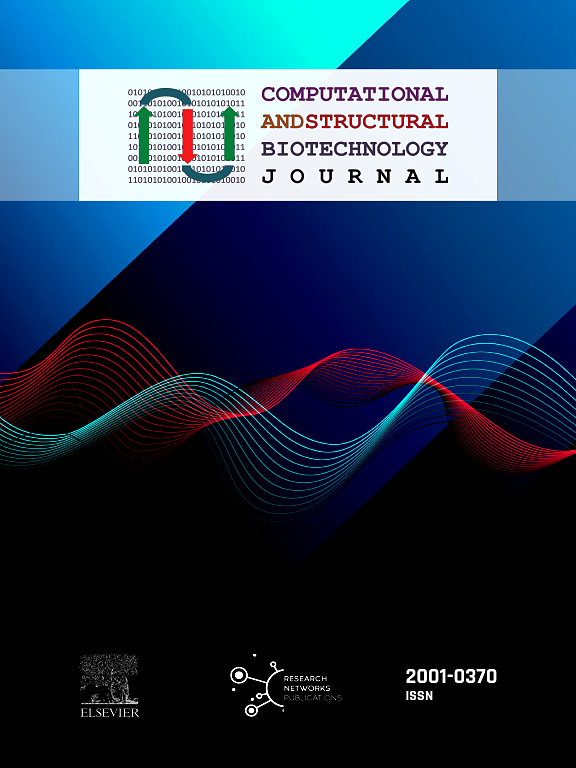Identification of genetic basis of brain imaging by group sparse multi-task learning leveraging summary statistics
IF 4.4
2区 生物学
Q2 BIOCHEMISTRY & MOLECULAR BIOLOGY
Computational and structural biotechnology journal
Pub Date : 2024-09-03
DOI:10.1016/j.csbj.2024.08.027
引用次数: 0
Abstract
Brain imaging genetics is an evolving neuroscience topic aiming to identify genetic variations related to neuroimaging measurements of interest. Traditional linear regression methods have shown success, but their reliance on individual-level imaging and genetic data limits their applicability. Herein, we proposed S-GsMTLR, a group sparse multi-task linear regression method designed to harness summary statistics from genome-wide association studies (GWAS) of neuroimaging quantitative traits. S-GsMTLR directly employs GWAS summary statistics, bypassing the requirement for raw imaging genetic data, and applies multivariate multi-task sparse learning to these univariate GWAS results. It amalgamates the strengths of conventional sparse learning methods, including sophisticated modeling techniques and efficient feature selection. Additionally, we implemented a rapid optimization strategy to alleviate computational burdens by identifying genetic variants associated with phenotypes of interest across the entire chromosome. We first evaluated S-GsMTLR using summary statistics derived from the Alzheimer's Disease Neuroimaging Initiative. The results were remarkably encouraging, demonstrating its comparability to conventional methods in modeling and identification of risk loci. Furthermore, our method was evaluated with two additional GWAS summary statistics datasets: One focused on white matter microstructures and the other on whole brain imaging phenotypes, where the original individual-level data was unavailable. The results not only highlighted S-GsMTLR's ability to pinpoint significant loci but also revealed intriguing structures within genetic variations and loci that went unnoticed by GWAS. These findings suggest that S-GsMTLR is a promising multivariate sparse learning method in brain imaging genetics. It eliminates the need for original individual-level imaging and genetic data while demonstrating commendable modeling and feature selection capabilities.通过利用汇总统计的群体稀疏多任务学习识别脑成像的遗传基础
脑成像遗传学是一个不断发展的神经科学课题,旨在确定与相关神经成像测量有关的遗传变异。传统的线性回归方法取得了成功,但它们对个体水平成像和遗传数据的依赖限制了其适用性。在此,我们提出了 S-GsMTLR,这是一种群体稀疏多任务线性回归方法,旨在利用神经影像定量性状的全基因组关联研究(GWAS)的汇总统计数据。S-GsMTLR 直接利用全基因组关联研究(GWAS)的汇总统计数据,绕过了对原始成像基因数据的要求,并将多变量多任务稀疏学习应用于这些单变量 GWAS 结果。它综合了传统稀疏学习方法的优势,包括复杂的建模技术和高效的特征选择。此外,我们还实施了一种快速优化策略,通过识别整个染色体上与感兴趣表型相关的遗传变异来减轻计算负担。我们首先使用从阿尔茨海默病神经成像计划中提取的汇总统计数据对 S-GsMTLR 进行了评估。结果非常令人鼓舞,证明了它在建模和识别风险基因位点方面与传统方法的可比性。此外,我们还用另外两个 GWAS 简要统计数据集对我们的方法进行了评估:一个数据集侧重于白质微结构,另一个数据集侧重于全脑成像表型,因为这两个数据集没有原始的个体水平数据。结果不仅凸显了 S-GsMTLR 精确定位重要基因座的能力,还揭示了 GWAS 没有注意到的遗传变异和基因座内部的有趣结构。这些发现表明,S-GsMTLR 是脑成像遗传学中一种前景广阔的多元稀疏学习方法。它不需要原始的个体级成像和遗传数据,同时展示了值得称道的建模和特征选择能力。
本文章由计算机程序翻译,如有差异,请以英文原文为准。
求助全文
约1分钟内获得全文
求助全文
来源期刊

Computational and structural biotechnology journal
Biochemistry, Genetics and Molecular Biology-Biophysics
CiteScore
9.30
自引率
3.30%
发文量
540
审稿时长
6 weeks
期刊介绍:
Computational and Structural Biotechnology Journal (CSBJ) is an online gold open access journal publishing research articles and reviews after full peer review. All articles are published, without barriers to access, immediately upon acceptance. The journal places a strong emphasis on functional and mechanistic understanding of how molecular components in a biological process work together through the application of computational methods. Structural data may provide such insights, but they are not a pre-requisite for publication in the journal. Specific areas of interest include, but are not limited to:
Structure and function of proteins, nucleic acids and other macromolecules
Structure and function of multi-component complexes
Protein folding, processing and degradation
Enzymology
Computational and structural studies of plant systems
Microbial Informatics
Genomics
Proteomics
Metabolomics
Algorithms and Hypothesis in Bioinformatics
Mathematical and Theoretical Biology
Computational Chemistry and Drug Discovery
Microscopy and Molecular Imaging
Nanotechnology
Systems and Synthetic Biology
 求助内容:
求助内容: 应助结果提醒方式:
应助结果提醒方式:


